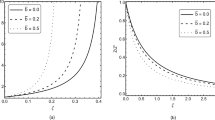Abstract
Thermal cracks of mode I type oriented normal to the surface along an initial scratch were generated by blowing cold nitrogen gas through a small nozzle onto the surface of a glass plate. Acoustic emission (AE) signals emitted from the thermal cracks were detected on the opposite side of the plate, both at epicentral and at off-epicentral positions with a nine-channel AE system. AE source characteristics, such as moment tensor components, source-time function, radiation pattern, and dipole strength, were obtained from the detected waveforms. The strength of dipoles associated with the thermal cracks was determined from comparing the crack signals to those generated when a glass capillary was broken at the crack site prior to crack formation. It is shown that the AE source-time function, together with the dipole strength, can provide valuable information on the dynamic behavior of fracture.
Résumé
On a créé des fissures thermiques de Mode I orientées normalement à une surface en projetant de l'azote froid par un petit ajustage sur une rainure initiale à la surface d'une plaque de verre. Les signaux d'émission acoustique émis par la fissure thermique ont été détectés sur la face opposée de la plaque, à l'épicentre et en d'autres positions par rapport à la fissure, en utilisant un système de captation à neux canaux. Les formes d'ondes détectées fournissent les caractéristiques de la source acoustique, telles que les composantes du tenseur de moment, la fonction sourcetemps, la répartition de la radiation et la puissance du dipole. Cette dernière grandeur a été déterminée, lorsqu'elle est associée aux fissures thermiques, en comparant les signaux obtenus à ceux que produit un capillaire de verre rompu à l'endroit de la fissure, avant que celle-ci se forme. On montre que la fonction d'émission acoustique source-temps ainsi que la puissance dipole peuvent fournir des informations valables sur le comportement dynamique d'une rupture.
Similar content being viewed by others
References
K.Aki and P.G.Richards, Quantitative Seismology: Theory and Methods, Vol. I, Freeman, San Francisco (1980) Chapter 3.
K.Y. Kim and W. Sachse, in Progress in Acoustic Emission II, M. Onoe, K. Yamaguchi, and H. Takahashi, Ed., Proceedings of the 7th International Acoustic Emission Symposium, Zao, Japan, October 23–26, Japanese Society for Non-destructive Evaluation (1984) 163–172.
K.Y.Kim and W.Sachse, Journal of Applied Physics 59 (1986) 2704–2710; 2711–2715.
L.Knopoff, Journal of Applied Physics 29 (1958) 661–670.
N.N.Hsu, J.A.Simmons, and S.C.Hardy, Materials Evaluation 35 (10) (1977) 100–106.
Y.H.Pao and R.R.Gajewski, in Physical Acoustics, Vol. XIII, W.P.Mason and R.N.Thurston, Ed., Academic Press, New York (1977) 183–265.
A.N.Ceranoglu and Y.H.Pao, Transactions of ASME 48 (1981) 125–132; 48 (1981) 133–138; 48 (1981) 139–147.
K.Y.Kim and W.Sachse, Journal of Applied Physics 55 (1984) 2847–2856.
W.Nowacki, Thermoelasticity, Addison-Wesley, London (1962) 102–113.
F.Gilbert, Geophysical Journal of the Royal Astronomical Society 22 (1970) 223–226.
D.J. Doornbos, in Identification of Seismic Sources-Earthquake or Underground Explosion, E.S. Husebye and S. Mykkeltvert, Ed., D. Reidel Publishing Co. (1981) 207–232.
G.Bachus and M.Mulcahy, Geophysical Journal of the Royal Astronomical Society 46 (1976) 341–361.
G.Bachus and M.Mulcahy, Geophysical Journal of the Royal Astronomical Society 47 (1976) 301–329.
A.E.H.Love, A Treatise on the Mathematical Theory of Elasticity, Dover Publications, New York, Fourth ed., (1944) 186–189.
P.M.Morse and H.Feshbach, Methods of Theoretical Physics, McGraw-Hill, New York (1953) Part I, Chapter 7.
G.Bachus, Geophysical Journal of the Royal Astronomical Society 51 (1977) 1–25; 51 (1977) 27–45.
J.E.Michaels and Y.H.Pao, Journal of the Acoustical Society of America 77 (1985) 2005–2011.
D.S.Dugdale, Journal of the Mechanics and Physics of Solids 8 (1960) 100–104.
G.I.Barenblatt, Advances in Applied Mechanics 7 (1962) 55–129.
J.R.Rice, Journal of Applied Mechanics 35 (1968) 379–386.
A.A.Griffith, Philosophical Transactions of the Royal Society, London, A 221 (1920) 163–198.
Author information
Authors and Affiliations
Rights and permissions
About this article
Cite this article
Kim, K.Y., Sachse, W. Characteristics of an acoustic emission source from a thermal crack in glass. Int J Fract 31, 211–231 (1986). https://doi.org/10.1007/BF00018928
Received:
Issue Date:
DOI: https://doi.org/10.1007/BF00018928




